Number Logic Puzzles Rules
Sudoku
Geen blokken (latijns vierkant)
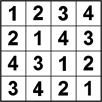 | Het latijnse vierkant is een vierkant gevuld met verschillende cijfers die elk precies één keer in een kolom en in een rij voorkomen. Regels voor het latijnse vierkant:
|
Rechthoekige blokken
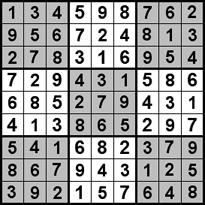 | De meest voorkomende versie zijn de vierkante blokken. Een 9x9 grid heeft 9 blokken, zoals je in de afbeelding ziet. Regels voor vierkante blokken:
|
Onregelmatige blokken (jigsaw)
 | Jigsaw puzzle is played the same as Sudoku, except that the grid has Irregular Blocks, also known as cages. Irregular Blocks Rules:
|
Diagonal Variants
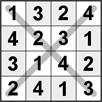 | It is common to add limits on the placement of the digits, beyond the usual row and column. One of the limits is the Diagonal Variant. Diagonal Variants Rule:
|
Combined Variants
 | Variants can be combined. For example: the grid can have both Rectangular Blocks and Diagonal Lines. There can also be more than 2 diagonal lines. Rectangular Blocks and Diagonal Variants Rules:
|
Overlapping Variants
Overlapping variant consits of several puzzles. Shared blocks are highlighted by a different color. Here are some examples of overlapping Sudokus:


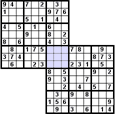
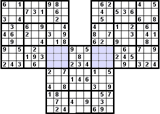
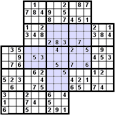
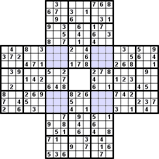

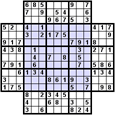
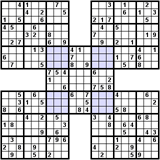
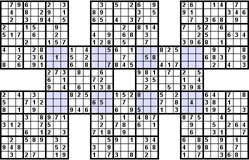
Killer
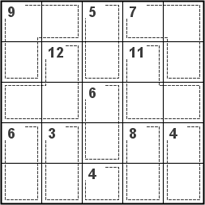 | The grid of the Killer Sudoku is covered by cages (groups of cells), marked with dotted outlines. Each cage encloses 2 or more cells. The top-left cell is labeled with a cage sum, which is the sum of all solution digits for the cells inside the cage. Killer Sudoku Rules:
|
Greater/Less Than
 | Greater Than (or Less Than) Sudoku has no given clues (digits). Instead, there are "Greater Than" (>) or "Less Than" (<) signs between adjacent cells, which signify that the digit in one cell should be greater than or less than another. Greater Than / Less Than Rules:
|
Kakuro
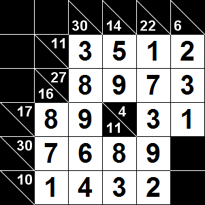 | Kakuro is played on a grid of filled and barred cells, "black" and "white" respectively. The grid is divided into "entries" (lines of white cells) by the black cells. The black cells contain a slash from upper-left to lower-right and a number in one or both halves. These numbers are called "clues". Kakuro Rule:
|
Kalkuldoku
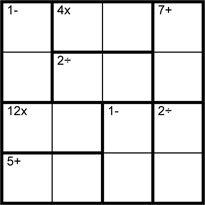 | The grid is divided into heavily outlined cages (groups of cells). The numbers in the cells of each cage must produce a certain "target" number when combined using a specified mathematical operation (either addition, subtraction, multiplication or division). Kalkuldoku Rules:
|
Futoshiki
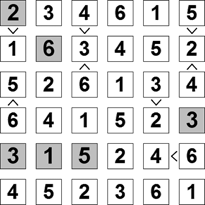 | Futoshike wordt gespeeld op een veld dat al een aantal cijfers kan bevatten. Aanvullend zie je "groter dan" (>) en "kleiner dan" (<) tekens tussen de aangrenzende velden. Deze betekenen dat het getal in het ene veld groter of kleiner moet zijn als dat in het andere veld. Futoshiki regels:
|
Straights
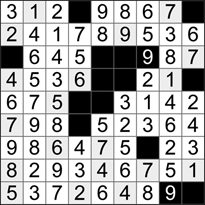 | Straten (Straights) hebben een veld dat met zwarte vakjes is onderverdeeld in gedeeltes. Elk gedeelte moet een straat bevatten - een reeks opvolgende nummers - maar de volgorde is willekeurig. Bijvoorbeeld: 2-1-3-4). Er kunnen ook witte aanwijzingen in de zwarte cellen staan. Straten regels:
|
Skyscraper
 | The Skyscraper puzzle has numbers along the edge of the grid. Those numbers indicate the number of buildings which you would see from that direction if there was a series of skyscrapers with heights equal the entries in that row or column. For example: if the line has 4 cells and if the first number in the cell is 4, you will see only one skyscraper because the 4-floor skyscraper hides the 1-floor, 2-floor, and 3-floor skyscrapers. Skyscrapers Rules:
|
Skyscrapers with Parks
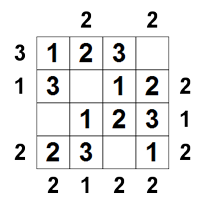 | The Skyscrapers puzzle can have Parks (empty cells). Skyscrapers with Parks Rules:
|
Sum Skyscrapers
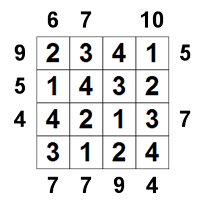 | The numbers along the edge of the Sum Skyscraper grid indicate the sum of heights of the visible buildings. Sum Skyscrapers Rules:
|
Binary
 | Complete the grid with zeros (0's) and ones (1's) until there are just as many zeros and ones in every row and every column. Binary Rules:
|
Bricks
 | Bricks is another type of Latin Square. Grid is divided into pairs and look like brick wall. Bricks rules
|

